The Swimsuit Series, Part 4: A Competitive Swimmer’s Musings
In Leanne Shapton’s Swimming Studies “Bathing” chapter, there’s a story behind every suit
![]() Artist and author Leanne Shapton trained for the Olympic swimming trials as a teenager. Her newest book, Swimming Studies, which was released this month, is a quiet, weightless and elegant collection of stories about the life of a swimmer who is inescapably drawn to the water even after she is no longer rigorously competing. To continue Threaded’s Swimsuit Series, and with the Summer Olympics around the corner, I’ve excerpted part of her chapter “Bathing” along with some of the book’s images of Shapton’s swimsuits and their accompanying provenances.
Artist and author Leanne Shapton trained for the Olympic swimming trials as a teenager. Her newest book, Swimming Studies, which was released this month, is a quiet, weightless and elegant collection of stories about the life of a swimmer who is inescapably drawn to the water even after she is no longer rigorously competing. To continue Threaded’s Swimsuit Series, and with the Summer Olympics around the corner, I’ve excerpted part of her chapter “Bathing” along with some of the book’s images of Shapton’s swimsuits and their accompanying provenances.
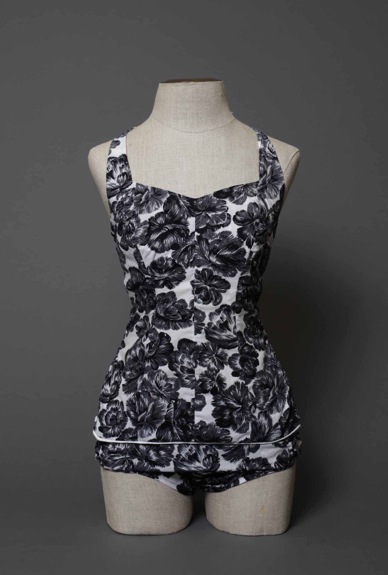
Vintage blue and white floral-printed cotton suit, no label, used for recreational swimming, 2006-2009. Purchased at Portobello Market, London. Worn first in the infinity pool at Babington House, Somerset. James proposed in the pool. We swam around not knowing what to say to each other, went on a long bicycle ride, took pictures; then later, in our small attic room, we fought and decided maybe marriage wasn’t a good idea.
Bathing implies having some contact with the ground while in the water—propulsion and speed are secondary. Bathing. Bathing: the word itself feels like a balm, a cleanse, rather than the wavy struggle of swimming. I wonder why swimming in North America feels different from swimming in Europe.
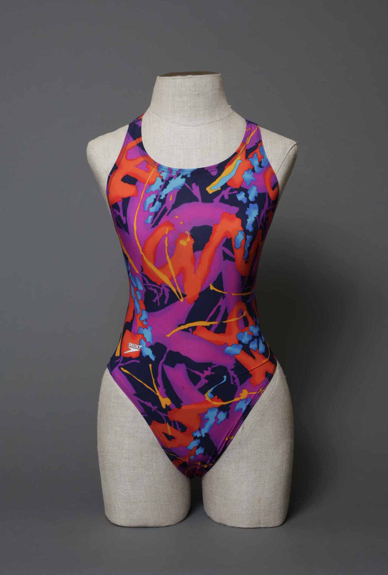
Speedo multicolored “paper suit,” used for competition, Canadian Olympic swimming trials, 1992.
Until the late seventeenth century, the sea was regarded as a place of danger and death, the aspect of houses was directed inland, sailors were not taught to swim, in order to foster in them a true respect for the sea. The ocean stank, was dangerous, belched up seaweed and flotsam, and was full of marauding pirates and monsters. The value of any coastline was in proportion to how fortified it was. Swimming instruction as military drill for men and horses began in the late eighteenth and early nineteenth centuries in northern Europe, accompanying developments in toilets and indoor plumbing.
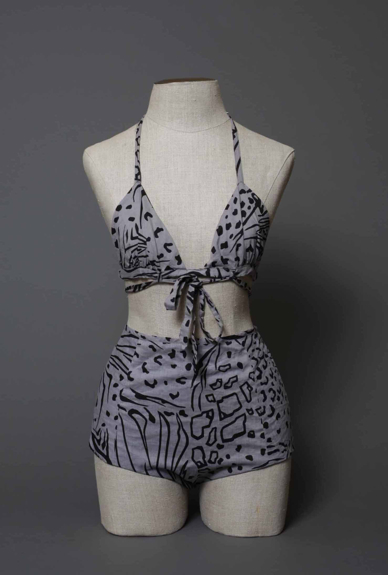
Rachel Comey, gray and black print two-piece, 2009. Traded for designing prints for Rachel’s Spring/Summer 2010 collection, not yet worn.
In The Springboard in the Pond: An Intimate History of the Swimming Pool, Thomas A. P. van Leeuwen talks about the impression physical activity made on European visitors to the United States in the 1890s: “Americans seem best to express their spiritual energy by moving their bodies, by running, walking fast, and competing in sports.”
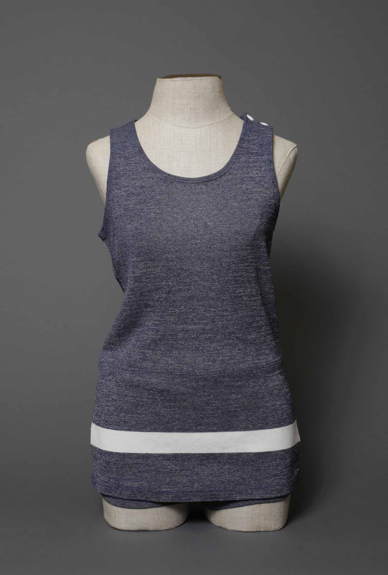
Vintage blue and white one-piece, no label used for recreational swimming, 2000. Stolen from Banff Upper Hot Springs, Banff, British Columbia.
I think of the only time my medals have come in handy, at the U.S. border crossing in Buffalo. As Jason and I pull up at the border after inching through a traffic jam from Toronto, a guard eyes us suspiciously and asks for our passports. We look a mess; the car reeks of B. O. and chicken nuggets. Vintage clothes are strewn across the backseat, moth-eaten blankets lumpily cover Jason’s camera equipment. One of my father’s art-college paintings is jammed between our luggage. I’m certain we’ll be pulled over to the side, as I often am, and interrogated. The guard gets out of his booth and asks me to pop the back. I do. Shuffling sounds, then: “Who’s the swimmer?” I smile at Jason. “I am.” The hatchback shuts quietly. The guard hands us our passports with no further questions, just “Drive safely.” Before I left my parents’ house I heaved a large tote bag into the car; in it were eight years’ worth of gold, silver, and bronze swimming medals.
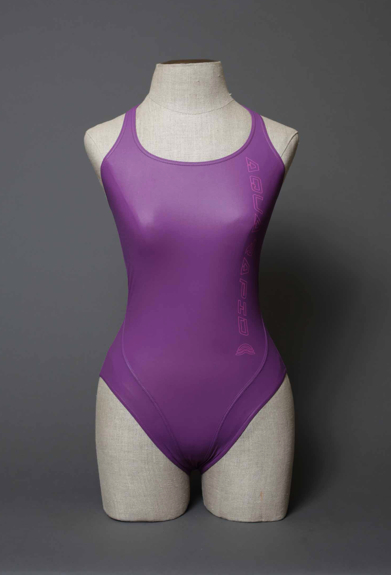
Aquarapid purple tank, bought in Turin, during the 2010 Artissima art fair, used for recreational swimming, 2010-2011. Worn in a Holiday Inn pool, Minneapolis, before attending the opening of Jason’s first solo museum show, at the Minneapolis Institute of Arts. Taped to a wall near the pool is a piece of paper that reads: POOL NOTICE: The black marks on the bottom of the pool were caused by a guest, who was an art student, and experimented with a waterproof marker. The pool is clean and safe. In order to remove the marks, we have to drain the pool. We have chosen to do that at a future slow period so that our guests can now enjoy the pool. Thank you, Management.
While visiting Berlin, I meet an artist who swims every morning, so I ask him about the city’s pools. He quickly makes a list of those he likes in my notebook. His daily laps are done at Stadtbad Mitte, in Gartenstrasse.
I head first to Stadtbad Charlottenburg– Alte Halle, a small, pretty pool nestled in the leafy streets of western Berlin. I borrow a pair of children’s goggles from the lifeguard booth and swim short widths beside a thick red rope bisecting the pool. A labored mural of Hylas and the Nymphs overlooks the deep end. The pool is beautiful but feels heavily furnished, like a parlor. The other swimmers seem to be annoyed by my splashing.
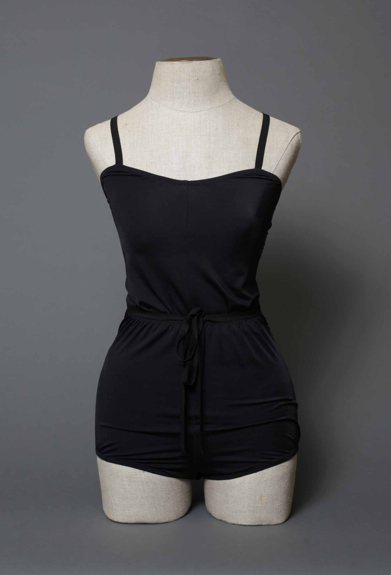
Lyell black smocked bathing suit, used for recreation swimming, 2010. A birthday present from James, worn swimming with Jason in Tunkhannock Creek, Pennsylvania, after stopping at an antiques store, coming across a Ku Klux Klan robe for sale, and leaving as quickly as possible.
Stadtbad Mitte, completed in 1930, is a soaring, gridded glass box. It is bright and unusually airy for a pool, thanks to its high mullioned transparent roof. (In 1945 its roof was struck by two Allied bombs—conceivably dropped by my grandfather or some friends of his—that failed to explode.) The deck is tiled in small pale gray squares; there are slurping gutters along the sides, two staircases that lead to a very shallow end, and a three-foot drop from the deck to the water’s surface that makes the pool feel contained, tanklike. There are only eight other swimmers, most doing relaxed but steady laps. In the deep end I sink to the bottom and look around. The swimmers glide calmly overhead, my bubbles rise, glittering. I push off the bottom.
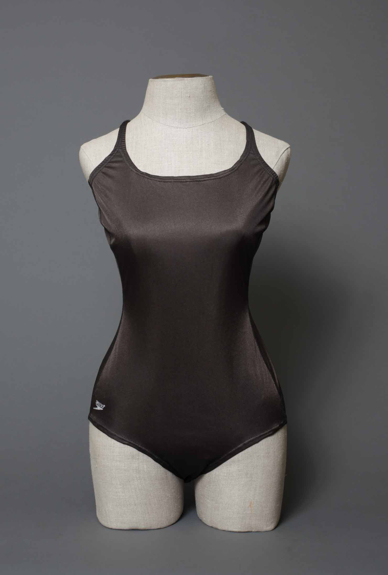
Speedo black nylon, used as a doubling suit for training, 1988–1992. We’d wear two, sometimes three suits to train in, the extra layers and weight providing drag. The suits were made of nylon, more durable and less flexible than Lycra. Some men’s suits were built with mesh pockets that caught the water and billowed out in small cups at the hips. Before practice, we would keep our drag suits resting down around our hips. At a meet we’d roll them down wet after warm-up, as ballerinas roll legwarmers up over their knees and then down around their ankles. A black nylon suit would fade to a grayish-brown over time; a blue nylon suit to pinkish-gray.
In Bath, England, for a literary festival, I visit the ancient Roman baths. Usually, any ruin filled with algae- greened water thrills me, but as I walk through the boxy displays and past the projected re-creations of “Romans” wearing too much mascara, I am bored. Even the two-thousand-year-old skeleton with cavities from eating honey does nothing for me. The statues the Victorians erected around the terrace overlooking the large outdoor pool upstage the real Roman stonework, the bath’s cruder but authentic roots. What I love, however, are the Roman curse tablets: tiny outrages scratched into pieces of lead and pewter and nailed to the wall, requesting that the gods visit misfortune on the heads of whoever stole their stuff while they were swimming. One reads:
To Minerva the goddess of Sulis I have given the thief who has stolen my hooded cloak, whether slave or free, whether man or woman. He is not to buy back this gift unless with his own blood.
I could relate, remembering the time my coral-pink Club Monaco sweatshirt was stolen from the Clarkson pool women’s locker room when I was thirteen. One minute I belonged to The Club of Monaco. Then suddenly I didn’t. My father was furious at the theft; on the chilly drive home his incredulity at my trust in other children vibrated in the car. I cursed the girl who had taken it.
Bathing chapter excerpted from Swimming Studies, copyright 2012 by Leanne Shapton, courtesy Blue Rider Press. Images: Michael Schmelling
(Another excerpt can be found at The Paris Review. Thanks to Rob Walker for the tip!)
/https://tf-cmsv2-smithsonianmag-media.s3.amazonaws.com/accounts/headshot/emily-spivack-240.jpg)
/https://tf-cmsv2-smithsonianmag-media.s3.amazonaws.com/accounts/headshot/emily-spivack-240.jpg)